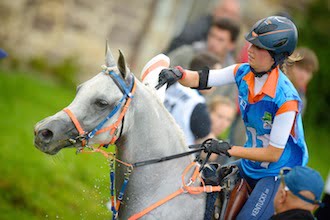
Whenever the word ‘endurance’ crops up in relation to horses, we all think of the vast distances that these unbelievably brave and strong horses cope with. However, endurance horses can benefit from cross-training. A beautifully schooled horse is a pleasure to ride – responsive and less likely to experience injury moving over rough terrain at speed.
Out of necessity endurance horses are not the biggest of horses, and those who carry heavyweight riders need to have exceptional balance, strength and suppleness to avoid unnecessary injury, especially if their rider is a novice. Cross-training allows a trainer to target a horse’s weak areas and improve on his strengths at the same time. Hard or overly sensitive mouths, weak backs, predisposition to sacroiliac strain, poor rhythm, poor balance, stiffness and jarring gaits as well as spookiness are all problems that can be improved by cross-training your endurance horse.
The value of dressage
Dressage teaches the endurance horse to be better balanced in a clearly defined, small area. Imagine it from the endurance horse’s perspective: usually he gets to move on long roads with no confines and no real demands on his suppleness except some turns and uneven ground. The training pyramid is an invaluable guideline for any horse in any discipline.

The ability to bend through figures like serpentines, spiralling in and out on circles, transitions, and lengthening and shortening of the pace all assist in the truly gymnastic development of the endurance horse. They learn a better connection from the hind leg over the back to the bit, and therefore become easier and more responsive to ride. Consider trotting or cantering at speed and having to ride sharp turns on a slippery surface. A well-balanced, supple horse manages them with the lightest aid from his rider. On the other hand, an unbalanced horse who doesn’t understand how to bend through his body or respond to his rider without tension or resistance may very well slip and fall.
Training an endurance horse to perform flying changes is also useful. To avoid fatiguing one leg more than the other, riders should regularly change diagonal at the trot, and the leading leg at the canter. One of the keys to riding successful endurance is the ability to maintain an easy, effortless rhythm, with the horse covering the maximum amount of ground with the minimum effort. Transitions from canter to trot back to canter in order to change lead are disruptive, unbalancing and eventually exhausting for horse and rider. It is invaluable to be able to ride flying changes effortlessly whether on a straight line, or to balance before a corner or turn.
The training scale
The dressage training scale addresses the following areas of schooling:
- Rhythm – energy and tempo
- Relaxation – elasticity and suppleness
- Connection – acceptance of the bit through acceptance of the aids
- Impulsion – increased energy and thrust
- Straightness – improved alignment and balance
- Collection – increased engagement, lightness of forehand and self-carriage
Text: Mandy Schroder, Photography: Shutterstock, FEI
The full article appears in the April 2015 issue of HQ Magazine.

